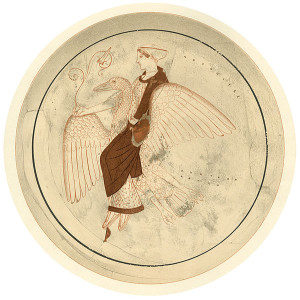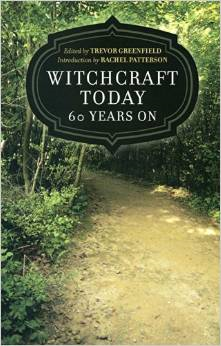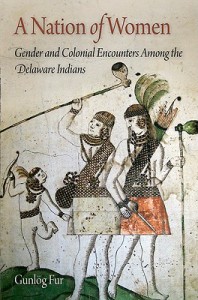
A study published earlier this year out of the State University of New York – Buffalo, finding that men are more narcissistic than women, was met with jokes and derision for being yet another academic examination of the obvious, but author Emily Grijalva responded eloquently that it is precisely those things that “everybody knows” that need to be examined. Not simply because they might not be true, although (obviously) there is a chance that they are false: establishing a fundamental fact (the what) allows us to move on to questions of why or how.
I thought of Grijalva’s words when I saw the promotion for Breaking the Mother Goose Code, about Mother Goose as a surviving form of the Mother Goddess. I believe I may have heard this idea from Z Budapest in the mid-1980s, but I don’t believe she made any claim to have researched this herself. I began showing my own students a picture of Aphrodite on her goose and calling her an early form of Mother Goose, and I don’t think it occurred to me or to anyone to examine the assumption.
In Breaking the Mother Goose Code Jeri Studebaker chronicles her effort to pin down the source of the nursery character, and on the journey with Mother Goose finds a long history of suppression of the Mother Goddess. Without delving exhaustively into the patriarchal takeover of Europe and the Christian takeover of religion, Studebaker provides the background for understanding why Mother Goose is such a powerful figure and how Christianity changed her. Studebaker gives a history of the fairytale and a synopsis of the prevalent theories for how European fairytales developed. There is a more detailed examination of the German goddess Holda than most women will be familiar with, along with some discussion about the goddesses Baba Yaga, Mari, Brigid and Aphrodite. There is some examination of theater history related to the Harlequin that appears in one of the rhymes. In addition to a history of their publication, Studebaker goes through the nursery rhymes line by line and attempts to decipher them. This involves a great deal of conjecture, but apparently this author is intrepid.
Studebaker’s intuition is on track in the avenues she explores, even when she admits that her evidence is tenuous. In some cases she seems to be unaware of information that would bolster her arguments further. I do disagree with her argument about classic fairytales created as an underground Pagan resistance movement. If anything, I think these fairytales were created as allegories against rival Christian institutions. I was going to expound on this, but it’s a rather esoteric point.
There is some great supplemental material in the appendices: a glossary, a list of fairytale codewords, a synopsis of the stories in Tales of Mother Goose, two timelines, and the full text of a Holda fairytale. The author did not neglect to provide references, a bibliography, and an index, which in this case were essential.

All in all I really liked this book (except for the pictures – did I mention that?). I hope the author will return to the subject of nursery rhymes, including Mother Goose. While the book is a respectable 300 pages there is still a lot of gold to mine here.




 It turns out that humans are highly anthropocentric in how we conceive of vision. The measures that we use tend to be areas where problems in human vision arise: focusing at distant and close range, seeing at night, depth perception, field of vision, and colorblindness. We don’t factor in things that most humans can do easily, such as recognize patterns, and we also don’t think about things we can’t do at all, such as recognize the source of diffuse light.Here is a list of factors that vision entails (which may not be complete):
It turns out that humans are highly anthropocentric in how we conceive of vision. The measures that we use tend to be areas where problems in human vision arise: focusing at distant and close range, seeing at night, depth perception, field of vision, and colorblindness. We don’t factor in things that most humans can do easily, such as recognize patterns, and we also don’t think about things we can’t do at all, such as recognize the source of diffuse light.Here is a list of factors that vision entails (which may not be complete): So which animal has the best vision? I was a few chapters into this book before I realized what a silly question this is. Each animal has a type of vision perfectly adapted to its environmental niche. No eye or set of eyes can function in all areas extraordinarily well, because there are a few areas that are mutually exclusive and so it’s a choice between specialization or compromise. If I did have to pick the animal with the best vision, however, it would be any member of the ape family, including humans. No doubt many will not believe me and will dismiss this as more anthropocentricism. I say this because while there are animals who outperform us in every area of vision, except perhaps pattern recognition, our eyes function competently in a wide range of environments and circumstances. Our eyes do little that is spectacular but almost everything well. This is probably the main reason we have adapted to so many environments around the globe.SourceSinclair, Sandra. How Animals See: Other Visions of Our World. New York: Facts on File, 1985.Photo credits: Eagle–Vtornet; Chimpanzee–Thomas Lersch
So which animal has the best vision? I was a few chapters into this book before I realized what a silly question this is. Each animal has a type of vision perfectly adapted to its environmental niche. No eye or set of eyes can function in all areas extraordinarily well, because there are a few areas that are mutually exclusive and so it’s a choice between specialization or compromise. If I did have to pick the animal with the best vision, however, it would be any member of the ape family, including humans. No doubt many will not believe me and will dismiss this as more anthropocentricism. I say this because while there are animals who outperform us in every area of vision, except perhaps pattern recognition, our eyes function competently in a wide range of environments and circumstances. Our eyes do little that is spectacular but almost everything well. This is probably the main reason we have adapted to so many environments around the globe.SourceSinclair, Sandra. How Animals See: Other Visions of Our World. New York: Facts on File, 1985.Photo credits: Eagle–Vtornet; Chimpanzee–Thomas Lersch Most of us intuitively understand that other animals do not see the world the way we humans do, and we like to imagine how things look from their point of view. It turns out that the ways of seeing are more intricate and varied than we realize.I am returning this week to a favorite topic of mine: vision. Over the next several weeks I will be sharing insights gleaned from my perusal of an out-of-print book,
Most of us intuitively understand that other animals do not see the world the way we humans do, and we like to imagine how things look from their point of view. It turns out that the ways of seeing are more intricate and varied than we realize.I am returning this week to a favorite topic of mine: vision. Over the next several weeks I will be sharing insights gleaned from my perusal of an out-of-print book, 


